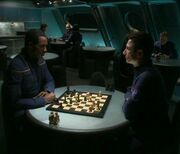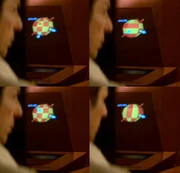
Travis Mayweather and Malcolm Reed play chess

Spherical chess during Spock's memory test
Chess was a tactically and intellectually advanced Human board game played by two opponents, one controlling white pieces and the other controlling black.
History
In 2154, Ensign Travis Mayweather and Lieutenant Malcolm Reed played chess while inhabited by Organians. Lieutenant Reed told Ensign Mayweather that he was the best player of chess aboard the NX-class starship Enterprise. (ENT: "Observer Effect")
By 2265, a three-dimensional variant had been devised and was available to the crew of the Constitution-class USS Enterprise. James T. Kirk and Spock frequently enjoyed playing it together. (TOS: "Where No Man Has Gone Before", "Charlie X", "Court Martial", "By Any Other Name", "Whom Gods Destroy")
In 2266, during a confrontation with the First Federation vessel Fesarius, Spock likened the situation to chess in which one is lost when overpowered. However, Kirk noted that it's rather like poker, a game in which one can overcome a losing situation by bluffing. (TOS: "The Corbomite Maneuver")
Another variation of chess was used in Spock's memory test in 2286, which featured the game on a spherical grid. (Star Trek IV: The Voyage Home)
When the computer of the USS Enterprise-D was affected by nanites, it responded to an inquiry with "Pawn to King Three, Knight to Rook Four, Queen to Bishop Three". (TNG: "Evolution")
According to Captain Jean-Luc Picard, dealing with the Romulans was "always a game of chess". (TNG: "The Defector")
On stardate 44390.1, two chess tournaments took place aboard the USS Enterprise-D. (TNG: "Data's Day")
One of the false memories planted into Geordi La Forge's brain after being brainwashed by the Romulans was of making second place in a chess tournament on Risa. (TNG: "The Mind's Eye")
Benjamin Sisko and Jadzia Dax played a game of chess in early 2371. (DS9: "Equilibrium")
A house featured in the holonovel Janeway Lambda one had a chess set on display, its pieces set up. (VOY: "Persistence of Vision")
Despite the game's inherent complexity, some individuals have been dismissive of it. When Harry Kim referred to Kal-toh as "Vulcan chess", Tuvok claimed that "Kal-toh is to chess as chess is to tic-tac-toe". (VOY: "Alter Ego")
The Doctor claimed that his "cousin" (programming-wise) was a prize-winning chess program, not an electric shaver as Tom Paris joked. (VOY: "11:59")
In 2375, Lieutenant Commander Data told the Ba'ku resident Artim that his chess routines were quite advanced. (Star Trek: Insurrection)
Types
See also
Appendices
Background information
In an ultimately omitted scene from the final draft script of ENT: "The Council", Malcolm Reed admitted to hating chess.
Three chess sets "like the one featured in the Star Trek: Enterprise episode 'Observer Effect'" were sold during the It's A Wrap! sale and auction on eBay, and two three-dimensional chess sets were sold in the Christie's auction 40 Years of Star Trek: The Collection. [1]
In the final draft script of TOS: "Charlie X", an ultimately unused line of dialogue referred to the chess pieces used aboard the USS Enterprise as "Antarian metal chess pieces".
In a revised draft script for TOS: "The Galileo Seven", a game of chess, played in Captain Kirk's quarters, was featured at the start of the episode's teaser. In a memo to Gene Roddenberry (dated 23 August 1966), Robert Justman suggested omitting the chess game and instead having the entire teaser set on the Enterprise's bridge.
An unfilmed line from TNG: "Coming of Age" suggests that the Mordock Strategy was a strategy in Benzite Chess. The script of "Empok Nor" described the Cardassian game of Kotra as being "a cross between chess and Stratego".
The chess nomenclature used for the computer's lines in TNG: "Evolution", English Descriptive Notation, has become highly uncommon in the early 21st century, in favor of the far more efficient Algebraic Notation method, which was developed during the early decades of the 20th century.
External links
- Chess at Wikipedia
- Chess at Memory Beta, the wiki for licensed Star Trek works
